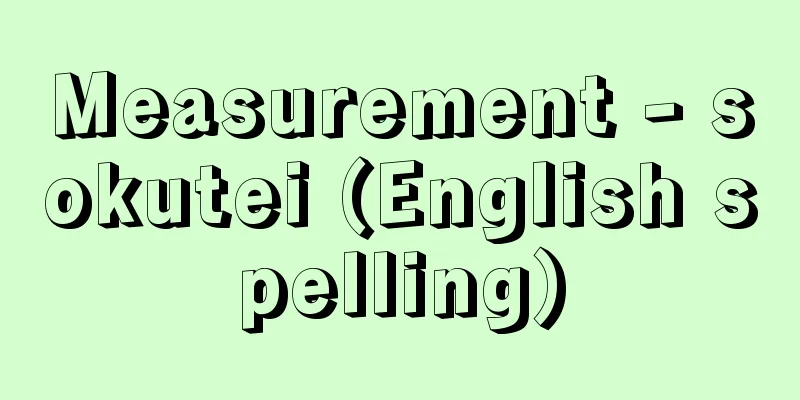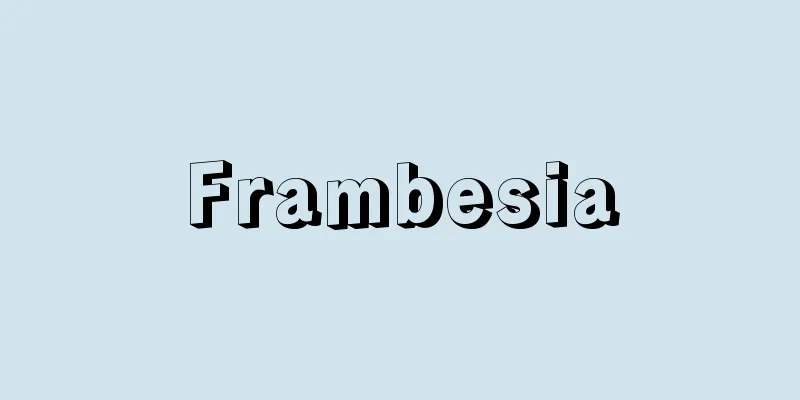Measurement - sokutei (English spelling)

|
Measurement is the act of expressing the attributes of things, events, and people as numbers. In psychology, it is the act of assigning numbers to constructs such as intelligence and anxiety, and numbers are assigned so that the relationship between concepts corresponds to the relationship between numbers (Krantz,DH et al., 1971). For example, if Person A has a stronger personality attribute than Person B , the numbers V A and V B representing the strength of Person A 's and Person B 's characteristics are assigned so that V A > V B. In general, when the order of strength is given for a certain construct, numbers are assigned so that the order of the numbers representing the strength of the concept corresponds to the order of the strength of the concept. A ≿ B ⇔ V A ≧ V B Here, " A ≿ B " indicates that A is stronger than B or is equivalent in terms of concepts A and B , V A and V B are numerical values assigned to A and B , and ⇔ indicates the equivalence relationship if and only if. When a ratio relationship exists between the strengths of constructs, the ratio relationship should be made to match the ratio relationship between the corresponding numerical values. For example, when measuring brightness, if the brightness of A is twice that of B , a numerical value V A of A is assigned so that it is twice the numerical value V B of B. In general, when a ratio relationship exists between the concepts, The strength of A is k times the strength of B ⇔ V A = k・V B Assign values V A and V B so that the following holds true. Axiomatic measurement theory is a theory that axiomatically justifies the correspondence between the relationships between constructs and the relationships between numerical values. For example, in the property of an attribute called extensive, the relationship ≿ and the combination operation ∘ are given between the objects of measurement ( A , B , C , D ), and the following six axioms are established (Krantz, et al., 1971). ⒜ ≿ is a weak order. ⒝ ( A ∘ B )∘ C ≿ A ∘( B ∘ C ) (c) If A ≿ B , then A ∘ C ≿ C ∘ B d. If A ≻ B , then there exists a D such that A ≿ B ∘ D. ⒠ A ∘ B ≻ A ⒡ When A i = A i -1 ∘ A i , if there exists a B such that B ≻ A j for any A j , then A 1 , A 2 , ... are a finite sequence. Here, "≻" means "≿ and not ≾." In addition, the above axioms are simplified descriptions, so please refer to Krantz, DH et al. (1971) for a strict description. In this case, there exists a function φ from the object to positive real numbers such that (i) (ii) It has been mathematically proven that it satisfies the above. The existence of this function φ is called the representation theorem. Condition (i) states that when A has stronger properties than B , a corresponding magnitude relationship holds between the numerical values φ ( A ) and φ ( B ) assigned to them. Condition (ii) states that the numerical value φ ( A∘B ) assigned to the combination of A and B , A∘B , is the sum of the numerical values φ ( A ) and φ ( B ) assigned to A and B. In other words, the function φ maps the strength relationship between properties and the combination result to the numerical magnitude relationship and the result of the sum operation (this is called a homomorphic mapping). An example of a measurement with the aforementioned extensibility is physical length. In length, a larger numerical value is assigned to the longer one. 3m is longer than 2m. Also, the length of two lengths joined together is the sum of the numerical values of the original lengths. When a 3m piece is joined to a 2m piece, the total length is 5m (5=3+2). In the case of an attribute property called intensive, the property of the combine operation of extensibility does not hold. A 5m object joined with another 5m object is longer than 5m, but a 5°C object joined with a 5°C object does not become 10°C. Density is also a measurement that is not extensible, but has intensity. The characteristic of intensity is that the intensity of the result of a combine operation with itself is equal to its own intensity. A ∘ A ~ A The idempotence is true (Krantz, et al., 1971). Here, "~" means "≿ and ≾," that is, the strengths of the objects on both sides are equal. In the case of the above scalability measurement, when there exists a function φ′ in addition to φ that satisfies conditions (i) and (ii), there exists a constant α (iii) For example, in the case of the above length, when the numerical assignment in units of m is expressed as φ and the numerical assignment in units of cm is expressed as φ' , then φ' = 100 φ holds. When condition (iii) is satisfied between functions that assign values, the assignment method and the values, i.e., the scale, are called ratio scales. This means that the ratio of the values corresponds to the ratio of the intensities of the objects, and that the ratio of the values does not depend on the function φ . This can be seen from equation (iii) as Since the above holds, In addition to ratio scales, scale types are classified into nominal scales, ordinal scales, interval scales, etc., depending on their properties. There are also representation theorems for cases where an object is composed of a combination of two characteristics, such as the degree of discomfort associated with a combination of temperature and humidity. When the two characteristics of object a are a1 and a2 , and the characteristics of object b are b1 and b2 , they can be expressed as a = ( a1 , a2 ) and b = ( b1 , b2 ). There is an axiom system that deals with objects composed of these two characteristics called a conjoint structure. When certain conditions (axioms) are set in the conjoint structure, there exists an interval scale for the two characteristics, and It has been proven that this holds true. Various measurements are also performed in psychology. Stevens, SS, conducted research using a direct method called the magnitude estimation method, which involves reporting the subjective intensity of a physical quantity ψ , and discovered the power law ψ = aψ b . In addition to direct methods, there are indirect methods in which a model is constructed for the construct of the object to be measured, and the measured value of the construct is obtained as the parameter value of the model estimated from the data. For example, in the paired comparison method of Thurstone, LL (1927), the probability P of a comparative judgment of the intensity of two objects A and B (the sensation of A is stronger than that of B ) is expressed by the relationship between the random variables XA and XB on the psychological continuum of A and B , assuming a psychological continuum of sensations. The psychological values of A and B are given as the average values of XA and XB estimated from the probability of the comparative judgment obtained as data. There are various indirect methods based on models of constructs, among which item response theory expresses the rate of correct answers to test items as a function of ability θ, and estimates θ from the response patterns to the test items. In multidimensional scaling, values in a psychological multidimensional space of each object are estimated from the relationship of similarity or dissimilarity between the objects being measured. Stevens (1951) believed that the degree of progress of science can be judged by the degree of its use of mathematics, and that in order to do so, it is important to base the measurement of the subject (construct). When the relationship is expressed mathematically based on measured values, attention must be paid to its meaningfulness (Luce,RD et al., 2002). For example, consider the case where the relationship between the value of the physical intensity of a sound ψ and its value of its psychological intensity ψ is expressed as a power law ψ = aψ b . If the value of ψ is expressed as I when the unit of ψ is intensity (energy flow rate) and as p when the unit of ψ is sound pressure, then I ∝ p 2 is satisfied, so ψ = a I b ∝ ap 2 b . The power exponent is a value that depends on the physical unit, so if b is used for I, then 2 b is used for p . In other words , the power law itself holds true regardless of the physical unit and is meaningful, but the value of the power exponent must indicate the unit used. In general, laws need to clearly state the framework they apply to. For example, the laws of motion by Newton I. apply to a special coordinate system called an inertial system. Tests and measurements based on a person's subjective judgment of an object or object are called sensory tests, sensory inspections, or sensory evaluations. Sensory tests use psychophysical methods, which perform psychological measurements, or psychometric methods, which perform psychometric measurements. The combination of the sense organs that correspond to the stimulus to be measured may correspond to the eyes and light, the ears and sound, the tongue and the taste of food, the nose and the scent or odor, or the skin and the texture of fabric, or it may be based on a complex sense, such as the overall evaluation of a product. In addition to rating the strength, methods such as detecting stimuli and discriminating between differences are also used. Sensory tests are considered an application of psychological measurement methods, and psychometric methods are used to measure human evaluations of objects or objects that cannot be directly expressed by physical measurements, or to utilize human judgments. →Scale →Psychophysical Measurement Methods [Yasuharu Okamoto] Latest Sources Psychology Encyclopedia Latest Psychology Encyclopedia About Information |
|
測定とは,物やこと,および人を対象として,その属性を数値で表わすこと。心理学ではとくに知能や不安など構成概念としての属性を表わすものに数値を割り当てることであるが,ここで概念間の関係が数値間の関係と対応するように数値の割り当てが行なわれる(Krantz,D.H.et al.,1971)。たとえば,AさんはBさんよりある性格特性という属性を強くもつとき,AさんおよびBさんの特性の強さを表わす数値VAおよびVBをVA>VBを満たすように割り当てる。一般的には,ある構成概念についてその強さの順序関係が与えられているとき,その概念の強さを表わす数値の大小関係が概念の強さの順序関係に対応するように数値が割り当てられる。 A≿B ⇔ VA≧VB である。ここで,「A≿B」は概念AとBにおいてAの方がBより強いか同等であることを表わし,VAとVBはAとBに割り当てられた数値であり,⇔は同値関係if and only ifを表わす。 構成概念の強さの間に比の関係が成り立つとき,その比の関係が対応する数値の比の関係と一致するようにする。たとえば,明るさの測定においてAの明るさがBの明るさの2倍であるとき,Aの数値VAはBの数値VBの2倍であるように数値を割り当てる。一般に,当該概念の間に比の関係が成り立つとき, Aの強さはBの強さのk倍 ⇔ VA=k・VB が成り立つように数値VAとVBを割り当てる。 公理論的測定理論axiomatic measurement theoryは,構成概念間の関係と数値間の関係の対応を公理論的に正当化する理論である。たとえば,拡張性extensiveとよばれる属性の性質では,測定対象(A,B,C,D)間に関係≿と結合演算∘が与えられ,以下の六つの公理が設定されている(Krantz,et al.,1971)。 ⒜ ≿は弱順序である。 ⒝ (A∘B)∘C≿A∘(B∘C) ⒞ A≿BならばA∘C≿C∘B ⒟ A≻BならばA≿B∘DとなるDが存在する。 ⒠ A∘B≻A ⒡ Ai=Ai-1∘Aiであるとき,任意のAjに対してB≻AjとなるBが存在するならば,A1,A2,…は有限個の列である。 ここで,「≻」は「≿であって≾でない」ことを表わす。また,上の公理においては記述を単純化しているので,厳密な記述はクランツKrantz,D.H.ら(1971)を参照されたい。 このとき,対象から正の実数への関数φが存在して (ⅰ) (ⅱ) を満たすことが数学的に証明されている。この関数φが存在することを,表現定理representation theoremという。条件(ⅰ)は,Aの方がBより強い性質をもつとき,それらに割り当てられた数値φ(A)とφ(B)の間に対応する大小関係が成り立つことをいうものである。条件(ⅱ)は,AとBを結合したものA∘Bに割り当てられる数値φ(A∘B)が,AとBに割り当てられた数値φ(A)とφ(B)の和であることをいうものである。すなわち関数φは,特性の間の強弱関係と結合結果を数値の大小関係と和の演算結果に対応づけるものである(準同型写像という)。前述の拡張性をもつ測定としては,たとえば物理的な長さが挙げられる。長さでは,長い方に大きい数値が割り付けられる。3mは2mよりも長い。また,二つの長さをつなぎ合わせたものの長さは,元の長さの数値の和になっている。3mのものに2mのものをつなぎ合わせたとき,その長さは5m(5=3+2)になる。 強度性intensiveとよばれる属性の性質の場合は,拡張性の結合演算の性質が成り立たない。5mのものと5mのものをつなぎ合わせたものは5mより長いが,5℃のものと5℃のものを一緒にしても10℃にはならない。密度も同様に拡張性ではなく,強度性をもつ測定である。強度性の特徴は,自分自身との統合演算の結果の強度が自分自身の強度に等しい A∘A~A というベキ等性idempotenceが成り立つことである(Krantz,et al.,1971)。ここで,「~」は「≿かつ≾である」こと,すなわち両辺の対象の強度が等しいことを表わす。 上の拡張性測定の場合,条件(ⅰ)および(ⅱ)を満たす関数がφのほかにφ′が存在したとき,定数αが存在して (ⅲ) が成り立つ。たとえば上の長さの場合,mを単位とする数値の割り当てをφで,㎝を単位とする数値の割り当てをφ′で表わしたとき,φ′=100φが成り立つ。 数値を割り当てる関数の間に条件(ⅲ)が成り立つとき,それらの割り当て方および数値,すなわち尺度は比尺度ratio scale(比率尺度ともいう)とよばれる。これは,数値の比が対象の強度の比に対応していて,数値の比が関数φに依存しないことを意味する。このことは,(ⅲ)式から が成り立つことから, と導かれる。尺度の種類は比尺度のほかに,その性質によって名義尺度nominal scale,順序尺度ordinal scale,間隔尺度interval scaleなどが区別される。 温度と湿度の組み合わせに対する不快さの度合いのように,対象が二つの特性の組み合わせで構成されている場合の表現定理もある。対象aの二つの特性がa1とa2であり,対象bの特性がb1とb2であるとき,a=(a1,a2)およびb=(b1,b2)と表わされる。この二つの特性からなる対象を扱う公理系として,結合構造conjoint structureとよばれているものがある。ある条件(公理)を結合構造に設定すると,二つの特性に対する間隔尺度が存在して が成り立つことが証明されている。 心理学でもいろいろな測定が行なわれるが,スティーブンスStevens,S.S.は物理量ψの主観的感覚強度ψが直接報告可能であるとして,その主観的強度を報告させるマグニチュード推定法とよばれている直接法を用いて研究を行ない,ベキ法則ψ=aψbを見いだした。測定法としては,直接法のほかに,測定対象の構成概念についてのモデルを構成し,データから推定されるモデルのパラメータ値として構成概念の測定値を求める間接法がある。たとえばサーストンThurstone,L.L.(1927)の一対比較法では,二つの対象AとBの強度の比較判断の確率P(Aの感覚の方がBより強い)が,感覚の心理学的連続体を想定して,AとBの心理学的連続体上の確率変数XAとXBの関係によって表わされた。AおよびBの心理学的値は,データとして得られた比較判断の確率から推定されるXAとXBの平均値として与えられる。 構成概念についてのモデルに基づく間接法にはいろいろなものがあるが,項目反応理論ではテスト項目に対する正答率を能力θの関数として表わし,テスト項目に対する反応パターンからθの推定が行なわれる。また,多次元尺度法では,測定対象間の類似度あるいは非類似度の関係から各対象の心理学的多次元空間における値が推定される。 スティーブンス(1951)は,科学の進歩の度合いは,その数学の利用の程度によって判断できると考え,そのためには対象(構成概念)の測定の基礎づけが重要であるとした。測定値に基づいて,それらの関係を数学的に表わしたとき,その有意味性meaningfulness(Luce,R.D.et al,2002)に注意する必要がある。たとえば,音の物理的強さの値ψとその心理的強さの値ψの間の関係が,ベキ法則ψ=aψbで表わされた場合について考える。ψの単位が強さ(エネルギーの流量)であるときの値をIで,音圧であるときの値をpで表わすとき,I∝p2の関係があるのでψ=aIb∝ap2bとなる。ベキ指数は物理単位に依存して決まる値であり,Iのときbであれば,pのときは2bになっている。すなわち,ベキ法則そのものは物理単位によらずに成り立ち,有意味であるが,ベキ指数の値は用いられている単位を示す必要がある。一般に法則は,それが成り立つ枠組みを明示する必要がある。たとえばニュートンNewton,I.による運動力学の法則は,慣性系という特別な座標系において成り立つ。 物あるいは対象についての人による主観的判断に基づいて行なわれる検査・測定は,官能検査sensory test,sensory inspection,sensory evaluationとよばれている。官能検査では,心理学的測定を行なう精神物理学psychophysics的方法あるいは計量心理学psychometrics的方法が用いられる。測定対象の刺激と対応する感覚器官の組み合わせが,目と光,耳と音,舌と食品の味,鼻と香りあるいは臭い,皮膚と織物の風合いというように対応している場合のほか,商品に対する総合的評価のように複合的感覚による場合もある。また,強さの評定だけではなく,刺激の検出や差の弁別などの方法も用いられる。官能検査は心理学的測定法の一つの応用と考えられ,物理的測定量で直接表わすことのできない物,あるいは対象についての人による評価を測定する,あるいは人による判断を利用するために計量心理学的方法が活用されているといえる。 →尺度 →精神物理学的測定法 〔岡本 安晴〕 出典 最新 心理学事典最新 心理学事典について 情報 |
<<: Sogdiana - Sogdiana (English spelling)
Recommend
Africa - Africa (English spelling)
Overview The African continent has an area of a...
Fringeworm - Fringeworm
A general term for annelids belonging to the order...
Kanayama Kofun
<br /> A twin circular tumulus located in Se...
Image Orthicon Tube
…The television cameras of the time were iconosco...
Free Speech Movement
A student movement that sparked the American stude...
Northern Alps - Kita Alps
This is a Gifu kasutori shochu. Its name comes fro...
Vien, JM (English spelling) VienJM
…In particular, Anglo-Saxon painters who were not...
Ophelia pseudochinensis (English spelling) Opheliapseudochinensis
…[Toyokuni Hideo] [Nitta Aya]. … *Some of the ter...
Séraphine (English spelling)
September 2, 1864 - December 11, 1942 French pain...
Tory (USA) (English spelling)
…American colonists who were loyal to Great Brita...
Matsuya Writing - Matsunoya Hikki
Essays. Written by Oyamada Tomokiyo . A collection...
Stress strength
...When an external force acts on an object, the ...
Atavism - Atavism
This phenomenon occurs when an individual of a ce...
Interstitial Cell-Stimulating Hormone
…They are also called gonadotropic hormones. In v...
Whale wax - spermaceti
It is the solid matter that precipitates after coo...









